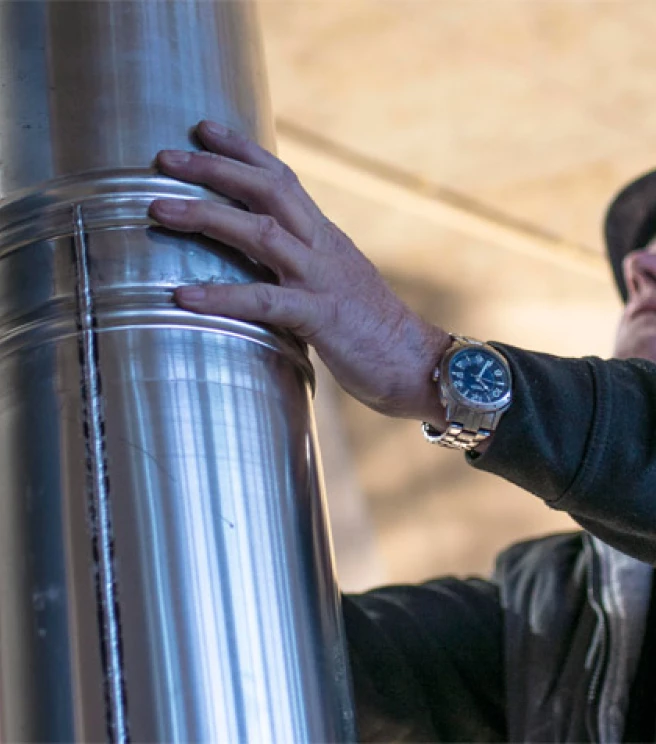
Kitchen extractors in new-build homes: what is the best method?
Energy-efficient houses are carefully constructed to ensure they are well insulated and airtight. Nevertheless, within a few years one in ten residents will have created a new outlet through the external wall for kitchen air extraction. The recirculation hood in its current form is a popular choice of kitchen extractor, but what are the pros and cons of the different systems?
What defines a good kitchen extractor?
A good kitchen extractor covers the following six functions and requirements:
Extracting fine particles;
Getting rid of odours;
Extracting moisture;
Reducing energy loss;
Supplying fresh air;
Ensuring minimum noise pollution from the system.
In short, a good kitchen extractor should meet energy, air quality and comfort requirements.
Kitchen extraction options in Lente-akkoord
On Lente-akkoord's initiative, the Better Kitchen Extraction interest group listed all available kitchen extraction options.
In theory, there are basically three principles of kitchen air extraction:
Option 1. Extract cooking air directly to the outside
An extractor hood with a direct external outlet effectively removes cooking air. This can be done directly through the outside wall, through the roof or using a conduit through the basement. However, heat is lost as soon as you make a hole in the wall.
Options to reduce this heat loss include insulation and automatic closure of the duct when the extractor is not in use. With an extractor moving air directly to the outside, you also need to think about the supply of fresh air to prevent creating lower pressure in the house.
If an extractor removes 300 m3 per hour, this means an intake of 300 m3 per hour. That will often require a separate mechanism. Achieving an adequate air supply is sometimes even more challenging than achieving good air extraction.
Option 2. Extract cooking air via the ventilation system
In principle, it is also possible to extract cooking air through the ventilation system. If you have balanced ventilation with an HRS you can then also recover heat.
Important points to address are the capacity of the kitchen extraction, and preventing contamination of the ventilation system, for example by grease deposits. Even with a mechanical ventilation system it is possible to extract some cooking air. This type of extractor is mostly found in social rental housing with a standard kitchen unit without an extractor hood.
The extraction fan in the kitchen has a capacity of at least 75 m3 per hour. Without an extractor hood, kitchen extraction takes place entirely through this fan, which is not sufficient to effectively remove cooking air and fine particles. Particles can linger for hours, particularly in an airtight home.
It is also possible to connect a hood without a motor to the extraction point in the kitchen to increase the effectiveness of the extraction. In this case, it is important that the resident sets the ventilation to the highest setting during cooking.
Option 3. Clean and recirculate cooking air
A third option is to extract cooking air, clean it and return it to the kitchen using a recirculation hood. This eliminates any need for wall openings for cooking air extraction and fresh air supply. This keeps the house airtight and no energy is lost.
Yet not everyone is very satisfied with this form of kitchen extractor. Not only do odours sometimes linger for a long time, the concentration of particles in the home after baking can be as high as along an urban motorway during rush hours.
That is why other solutions are needed to improve the effectiveness of a recirculation hood. Important considerations here are the quality of the filters and the residents willingness to clean or replace them regularly.
Recirculation using a carbon filter and fine particle filter
Most recirculation hoods only have a carbon filter. These filters can neutralise cooking odours, but do nothing about particles. A separate filter should be installed for this and replaced regularly. Maintenance costs make this an expensive form of kitchen air extraction, and it still does not capture any moisture.
Recirculation based on ionisation
Another way to clean cooking air is based on ionisation. During ionisation, water molecules are split into positively charged hydrogen ions and negatively charged oxygen ions. These ions pick up dust particles, which are then trapped using a filter. These filters also need to be cleaned regularly. One disadvantage of this process is that ozone may be released, which can be harmful to health.
Note: A recirculation hood is not suitable for use with a gas stove. Burning gas releases pollutants in gaseous form as well as ultrafine dust into the air. A recirculation hood cannot capture these contaminants and is therefore not suitable for use with a gas stove.

